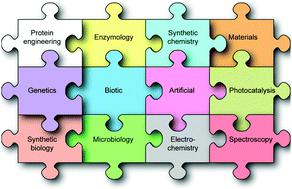当前位置:
X-MOL 学术
›
Chem. Soc. Rev.
›
论文详情
Our official English website, www.x-mol.net, welcomes your
feedback! (Note: you will need to create a separate account there.)
Semi-biological approaches to solar-to-chemical conversion.
Chemical Society Reviews ( IF 40.4 ) Pub Date : 2020-06-15 , DOI: 10.1039/c9cs00496c Xin Fang 1 , Shafeer Kalathil , Erwin Reisner
Chemical Society Reviews ( IF 40.4 ) Pub Date : 2020-06-15 , DOI: 10.1039/c9cs00496c Xin Fang 1 , Shafeer Kalathil , Erwin Reisner
Affiliation

|
This review presents a comprehensive summary of the recent development in semi-artificial photosynthesis, a biological-material hybrid approach to solar-to-chemical conversion that provides new concepts to shape a sustainable future fuelled by solar energy. We begin with a brief introduction to natural and artificial photosynthesis, followed by a discussion of the motivation and rationale behind semi-artificial photosynthesis. Then, we summarise how various enzymes can be combined with synthetic materials for light-driven water oxidation, H2 evolution, CO2 reduction, and chemical synthesis more broadly. In the following section, we discuss the strategies to incorporate microorganisms in photocatalytic and (photo)electrochemical systems to produce fuels and chemicals with renewable sources. Finally, we outline emerging analytical techniques to study the bio-material hybrid systems and propose unexplored research opportunities in the field of semi-artificial photosynthesis.
中文翻译:

太阳到化学转化的半生物学方法。
这篇综述全面总结了半人工光合作用的最新进展,这是一种生物材料混合的太阳能转化为化学方法,它提供了新的概念来塑造以太阳能为燃料的可持续未来。我们首先简要介绍自然和人工光合作用,然后讨论半人工光合作用的动机和原理。然后,我们总结了各种酶如何与光催化水氧化,H 2析出,CO 2的合成材料结合还原和更广泛的化学合成。在以下部分中,我们讨论将微生物纳入光催化和(光)电化学系统中以生产可再生资源的燃料和化学品的策略。最后,我们概述了新兴的分析技术,以研究生物材料混合系统,并提出了半人工光合作用领域中尚未探索的研究机会。
更新日期:2020-07-21
中文翻译:

太阳到化学转化的半生物学方法。
这篇综述全面总结了半人工光合作用的最新进展,这是一种生物材料混合的太阳能转化为化学方法,它提供了新的概念来塑造以太阳能为燃料的可持续未来。我们首先简要介绍自然和人工光合作用,然后讨论半人工光合作用的动机和原理。然后,我们总结了各种酶如何与光催化水氧化,H 2析出,CO 2的合成材料结合还原和更广泛的化学合成。在以下部分中,我们讨论将微生物纳入光催化和(光)电化学系统中以生产可再生资源的燃料和化学品的策略。最后,我们概述了新兴的分析技术,以研究生物材料混合系统,并提出了半人工光合作用领域中尚未探索的研究机会。











































 京公网安备 11010802027423号
京公网安备 11010802027423号